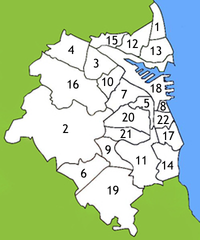- Oksywie
-
Oksywie (German: Oxhöft, Kashubian: Òksëwiô) is a neighbourhood of the city of Gdynia, Pomeranian Voivodeship, northern Poland. Formerly a separate settlement, it is actually several centuries older than the city it is a part of currently.
Etymology
Both the Polish and then German name of the town, as well as various other names for it used in the past (among them Oxsiua, Oxive, Okciua, Oxue, Oxivia, Oxiuia, Oxiwia, Oxiew and Oxivija) stem from a Scandinavian word oxihoved meaning oxen head.[citation needed]
History
In the pre-historic times the Oksywie Heights, overlooking the Bay of Gdańsk, was settled by the members of the Oksywie culture, named after the burial places located just outside Oksywie. With time the area was settled by Slavs and became part of Pomerania. Christianised relatively early, the settlement housed the first Catholic shrine erected in 1124 by Świętopełk, Duke of Pomerania. Throughout the ages, the settlement shared much of its history with the surrounding region and with the nearby town of Gdańsk (German: Danzig), which developed into a regional capital.
After the World War I, when Poland regained the area after more than 100 years of partitions, the town of Oksywie became the first base of the Polish Navy. It served this role until the outbreak of World War II. During the Polish Defensive War of 1939, the area was the battlefield of the 9 days long battle of Kępa Oksywska, in which the Polish forces under Col. Stanisław Dąbek defended the area between September 10 and September 19. During the last stages of the war, the area yet again became a battlefield, this time between March 28 and April 5, 1945, when the area of the Oksywie Heights became the last stand of the surrounded German forces in Pomerania.
Currently, the borough of Oksywie is notable as the seat of the Academy of the Polish Navy. It was also the namesake of ORP Oksywie.
Categories:- Poland stubs
- Gdynia
Wikimedia Foundation. 2010.

